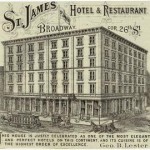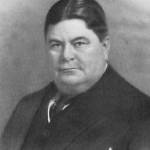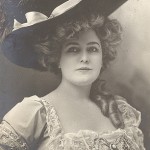Throughout his adult life, Diamond Jim Brady was a salesman working for pure commission. If he didn’t sell, he didn’t eat. Happily, his diverse and insatiable appetites were all the incentives he needed to earn a million dollars a year. Half a century after his death in 1917, Fortune called James Buchanan Brady the greatest capital goods salesman in American history.
He sold railroad equipment—spikes, plates, shovels, rail cutters, trucks, cars, and so forth—in the old-fashioned way, on the road ten months a year. His first big break had been a sale to George Baer of the Philadelphia & Reading, whose abstract dislike of humanity was crowned by a concrete loathing of salesmen. Brady camped in Baer’s outer office for five days. When Baer finally demanded to know why he was sitting there day after day, Brady said affably, “I’ve been waiting to tell you, Mr. Baer, that you can go straight to hell.” An hour later, he had an order for five million dollars’ worth of freight cars, and he and Baer were laughing and slapping each other on the back.
But Brady’s genius as a salesman paled beside his capacity for self-indulgence. The Cophetua of the Mauve Decade was born on August 12, 1856 above his father’s bar at 90 West Street, near Cedar Street. His father, a loyal Democrat, named him after that year’s Democratic Presidential nominee. At eleven, Brady began working as a bellboy at the St. James Hotel on Broadway and 26th Street. The hotel’s bar, as was then common, offered a free lunch counter for its patrons. Brady took his meals there until the bartender forbade it because Brady was eating for six men.
 Four years later, he began working for the New York Central Railroad. He studied bookkeeping and penmanship (he wrote a magnificently ornate hand and usually signed his name in full, deeming James Buchanan Brady a name worthy of a few flourishes).
Four years later, he began working for the New York Central Railroad. He studied bookkeeping and penmanship (he wrote a magnificently ornate hand and usually signed his name in full, deeming James Buchanan Brady a name worthy of a few flourishes).
In 1879, he began selling railroad supplies for Manning, Maxwell & Moore. Brady spent his savings on his first diamond ring and three superbly tailored suits to go with his Prince Albert coats, stove-pipe hats, gates-ajar collars, and white, round, detachable cuffs. “If you’re going to make money, you’ve got to look like money,” Brady said. As one biographer wrote, “If he may be said to have had a religion, that one sentence formed its ten commandments.”
As Brady traveled the country, he befriended countless railroaders: mechanics, section foremen, road gang supervisors, stationmasters, train crews, hostlers, firemen, and engineers. He gave parties, played cards, and swapped stories. In this way he learned what each railroad needed to complete its equipment. Then he would go to the companies’ front offices, tell the purchasing agents what they needed, and sell it to them. The orders poured in. He was making a million dollars a year by his thirtieth birthday. One day, after checking his accounts, he said, “Hell! I’m rich! It’s time to have some fun.”
He never stopped. He began collecting diamonds. Inevitably, someone would say they were fake. Brady would take one of the stones and write his signature with it in large and flowing letters on a window pane. It made his point while advertising his name.
Then, there was the food. “His gross displacement,” wrote humorist Irwin S. Cobb, “was awe-inspiring. He had a huge frame to start with and fat was draped upon it in creases and folds.” Another observer describes how when Brady ate, “An oversized napkin would be tied around, not tucked into, his neck.”
The napkin is inevitably placed, for on his knee it would have been as inadequate as a doily under a bass drum. It would have been lost, bewildered, in the shadow of one of the best known stomachs in New York, a stomach that started impetuously at the neck and gained power and curve as it proceeded majestically downwards.
In the morning, after a quart or two of fresh orange juice to tickle his taste buds (“I’m willing to pay more, and I’m willing to wait, but I want my oranges squeezed fresh!”), Brady had a light breakfast of beefsteak, a few chops, eggs, flapjacks, fried potatoes, hominy, cornbread, several muffins, and a huge beaker of milk. Around 11:30 a.m., he might renew his strength with, say, two or three dozen oysters or clams. Then, at 1:00 p.m., he lunched. This meal was apt to be heavier than breakfast and generally consisted of more oysters and clams, a deviled crab or two—or three—perhaps a pair of broiled lobsters (“The snapping and cracking of lobster claws,” one observer noted, “sounded like the descent of a cloud of seven-year locusts on a Montana wheat field.”), then a joint of beef or another steak, a salad, and several kinds of fruit pie. Brady topped this off with the better part of a box of chocolates. He felt it made the food set better.
Then came dinner: the big meal. In The Big Spenders, Lucius Beebe wrote that “so heroic were his skirmishes with the roasts, entrees, and pieces montees as to elevate them to an actually epic dimension.
Brady not only ate the full twelve-course dinner that was the conventional evening snack of the early decades of the last century, he usually consumed three or four helpings of the more substantial dishes, beginning his repast with a gallon of chilled orange juice and finishing with the greater part of a five pound box of the richest chocolates available. In between he might well consume six dozen Lynnhaven oysters, a saddle of mutton, half a dozen venison chops, a roasting chicken with caper sauces, a brace or so of mallard or canvasback ducks, partridge, or pheasant, and a twelve-egg soufflé.
There were bets taken on whether or not Brady would fall dead before dessert.
Once, a railroad president’s wife, having set before Brady and shore dinner of gigantic proportions and watched him devour it, even to the seventh helping, asked him how he knew when his appetite was satiated.
“Well, ma’am,” Brady explained, “Whenever I sit down to a meal, I always make it a point to leave just four inches between my stomach and the edge of the table. And then, when I can feel ’em rubbing together pretty hard, I know I’ve had enough.”
Yet he never touched alcohol, tea, or coffee. When he met the great John L. Sullivan at a friend’s bar in 1881, the bartender, knowing both men, gave Sullivan tall seidels of Pilsener and Brady tall seidels of root beer. Sullivan assumed Brady was drinking beer, and Brady did not disillusion him. During the next hour, Brady matched Sullivan drink for drink, never so much as turning a hair, Sullivan’s amazement grew. “By God, Sir!” he roared, “you’re a man. I’m proud to call you my friend! Shake hands again!”
Brady was always dressed at the height of conservative fashion, few noticing the slyly ingenious, perfect tailoring which softened the exaggeration of the ungainly figure. People did notice the dozens of diamonds giving off huge, glittering winks and ripples of light that covered his enormous chest and his cuffs, sparkling like a thousand tiny mirrors with every movement. He wore diamond studs instead of shirt buttons, diamond cuff links, a diamond pin in his tie, a watch and chain encrusted with stones, a boutonniere of diamonds. His belt buckle was a mass of diamonds and gold worked to form his initials, J.B.B. He even had a three-carat stone set in the ferrule of his cane.
He came to own thirty different sets of jewelry: one for each day of the month. They included more than 20,000 diamonds and over six thousand other stones. Each set included a watch, watch chain, ring, scarf pin, necktie pin, shirt studs, collar buttons, vest buttons, belt buckle, eyeglass case, pocketbook clasp, and even underwear buttons. As John Burke wrote in Duet in Diamonds, “…in full panoply, glittering with refracted light from stem to stern, he looked like a Mississippi riverboat at night coming around the bend with all its illumination turned on.”
Brady’s career on the road and his grotesque physique had early inclined him to patronize women of fragile virtue and, often, no virtue at all. His deeply suppressed romanticism escaped only through his efforts to soften the commercial nature of these relationships through giving the girls expensive jewelry rather than cash on the barrelhead.
He was a close friend of Stanford White, as profound a student and practitioner of debauchery as he was of architecture. One of Brady’s biographers found a man who had worked as a procurer for White and described a birthday party White had thrown for Brady in the Hall of Mirrors atop the old Madison Square Garden:
The meal proceeded uneventfully up to dessert. Then, a twinkle in his eye, [White] gave a signal and three of the waiters entered the room bearing aloft a huge Jack Horner–Pie. They carefully placed it in the center of the table, and then handed each of the gentlemen a white silk ribbon. Mr. Brady’s ribbon, I noticed, differed from the others. It was a red one.
At a sign from White, “all the gentlemen pulled on their ribbons” and “the pie fell apart revealing a beautiful and entirely nude girl nestled in the middle of it.”
Mr. Brady kept pulling in his red ribbon which, I could see, was fastened to the girl’s arm. And as he continued to pull, the girl got up and danced down the table to where he was sitting. She then climbed down of off the table and onto Mr. Brady’s lap where, after kissing him several times, she proceeded to feed him his dessert.
The other gentlemen guests were rather envious of Mr. Brady’s good fortune, and they proceeded to show their envy by loud wails and groans. After he had let them do this for a few minutes, the Governor smiled and suddenly clapped his hands. The doors opened and in came eleven other nude young ladies who also proceeded to feed the guests their dessert. It was a very pleasant evening.
 Yet Brady’s relationship with the most lusted-after woman in the United States—the blonde, blue-eyed, spectacularly voluptuous Lillian Russell—was entirely Platonic. America’s sex symbol during the 1880s and ’90s, Russell had made her mark as an actress and singer, but she was also a skillful card player and and an unerringly accurate tobacco spitter. Her extraordinarily warm, intimate friendship with Brady lasted for over thirty years. He was her frequent escort; they traveled and vacationed together; they confided in one another. She came to love him dearly. Sex, however, never entered into it.
Yet Brady’s relationship with the most lusted-after woman in the United States—the blonde, blue-eyed, spectacularly voluptuous Lillian Russell—was entirely Platonic. America’s sex symbol during the 1880s and ’90s, Russell had made her mark as an actress and singer, but she was also a skillful card player and and an unerringly accurate tobacco spitter. Her extraordinarily warm, intimate friendship with Brady lasted for over thirty years. He was her frequent escort; they traveled and vacationed together; they confided in one another. She came to love him dearly. Sex, however, never entered into it.
Unlike many self-made men, Brady remained sunny, generous, and sympathetic. He was a notorious soft touch. George Rector, the restaurateur, recalled once suggesting that people were taking advantage of Brady. “He looked at me, closed one eye in a wink, and said, ‘George, I know they’re all pullin’ my leg; but did you ever stop to think it’s fun to be a sucker, if you can afford it?'”
By the late winter of 1917, Brady was paying for a lifetime of heroic indulgence: ulcers, angina pectoris, diabetes, and malfunctioning kidneys. He did not complain, believing one’s capacity for taking losses to be a measure of one’s manhood. On Friday, April 13, 1917 he died in his sleep. Three days later, he was buried from St. Agnes’ Church on East 43rd Street, off Lexington. The congregation was jammed with actors, athletes, politicians, steel magnates, rail barons, gamblers, stock market speculators, and Lillian Russell, who wept.
New York Press, December 29, 1998